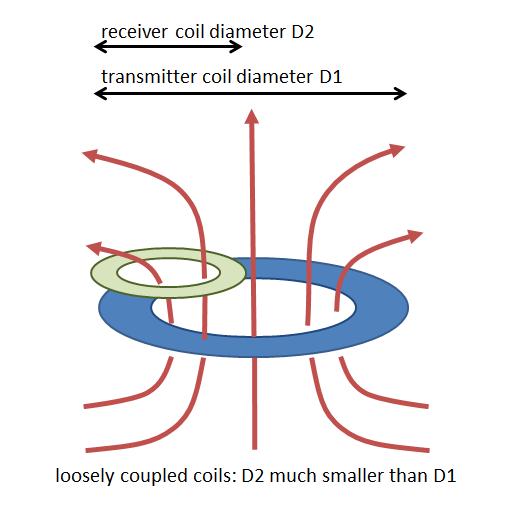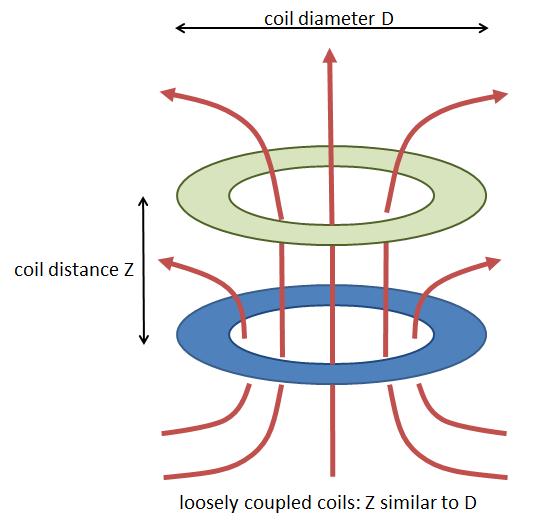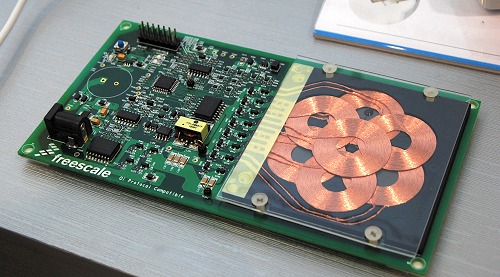The State of Wireless Charging Standards in Mobile
by Andrei Frumusanu on April 2, 2015 8:00 AM ESTInductive Coupling - The Basics
With the history of wireless charging out of the way, the remaining is question is how does it all work? To start, we need to understand the basics of inductive coupling.
Power transfer of inductive coupling happens by creating an alternating magnetic field on the transmitter coil, that magnetic flux is then converted into an electrical current in the receiver coil. The generated electrical current depends on the amount of flux generated by the transmitter coil, and how much of a percentage the receiver coil is able to capture. The distance, size, and positioning of the receiver coil relative to the transmitter coil decides the “coupling factor” of the two coils.
A higher coupling factor means a more efficient power transfer through loss reduction and less heating. In general, we differentiate between tightly coupled and loosely coupled systems.

Source: WPC
In tightly coupled systems, the transmitter and receiver coils both are of the same diameter size and aligned with each other with a minimal distance in-between them. This setup ensures most of the magnetic flux is captured by the receiver coil to be able to be converted into an electrical current.
Loosely coupled systems are defined by setups which do not capture all of the transmitter’s flux, either because the receiver coil distance is too big, or because the coil diameters don’t match and the receiver coil is smaller than the transmitter coil.


Source: WPC
While we mention loosely coupled systems and we’ll get back to them short when investigating Rezence charging, both WPC and PMA standards based on tightly coupled systems.
Optimal alignment of the transmitter to the receiver coil is crucial for a high coupling factor and high efficiency power transmission; because of this, there is a problem of practicality to actually achieve this alignment. To alleviate the issue, Qi transmitters allow for multiple transmitter coils that may overlap.

Source: WPC
By employing multiple transmitter coils over each other, we have a greater area of “optimal coupling” over which a device can be placed on. The control IC of the charging system will then detect which coil is best suited for the power transmission and then use that one for generating the magnetic flux. It is also possible to power on multiple coils simultaneously to achieve a higher power transfer if the receiver device is designed for it.
WPC & PMA Power Control
In Qi and PMA based systems, control over how the coils are powered is done via data communication between the transmitter and the receivers. This is done via data modulation (Either amplitude or frequency based) on the power carrier frequency. The in-band communication requires advanced signal processing and this is where manufacturers’ solution ICs come into play.
WPC wireless power functional diagram, Source: Texas Instruments
This communication is also the main difference and source of incompatibility between the Qi and PMA standards, as without a reliable and interoperable signal the charging process will not start. Powermat differs to Qi by using RFID handshake instead of modulation on the power signal.
The direction of power transfer is always from power transmitter to power receiver. The transmitter idles with in a low power state, which depending on vendor is in the 60mW range. When the power receiver detects a transmitter, it identifies itself to the transmitter as a compliant device and sends configuration information such as the desired charging power. Once power transfer is initiated, the receiver can send error packets requesting more or less power. The power transmission stops upon either receiving an “End Power” message or a period of non-communication of 1.25s.
The coils of a WPC-compliant device operate as resonant half-bridge on a 50% duty cycle with a 19V(±1V) DC power input. Depending on power demand, the frequency in the coil is modulated between 110 and 205 kHz. Powermat on the other hand works in the 277-357 kHz range.
On the receiver side, WPC gives the manufacturers much more liberty in terms of coil-design. While the transmitter is required to have a certain size and provide certain power for standard’s sake, the receiver is allowed to vary in size to adapt to the device form factor the system is implemented into.
Qi in its first low-power specification allows up to 5W of power transfer, with a revision on newer charging systems allowing up to 10W.
Unfortunately PMA does not publicize the standard’s specifications to non-members, so we don’t have any finer details on how it compares to Qi. It’s nevertheless safe to assume that the basic principles of the two standards work in similar fashion.











90 Comments
View All Comments
blanarahul - Thursday, April 2, 2015 - link
Exactly. They are trying to solve a problem that doesn't even exist.khanikun - Thursday, April 2, 2015 - link
We had regular mobile phones before. There was no problem to solve, but we still ended up getting smartphones.blanarahul - Thursday, April 2, 2015 - link
We got to smartphones little by little. First games, then E-Mail, then IM then something else and so on. So a need was slowly created. But with wireless charging, there is no need. It's just for a minor convenience.khanikun - Friday, April 3, 2015 - link
There was never a need or a problem. It was simply companies creating something and pushing it onto the market, to try and differentiate themselves from everyone else. Get you to buy their product instead of someone else's product.The same with all these random features we get now on phones. NFC, wireless charging, etc.
Murloc - Tuesday, April 7, 2015 - link
smartphones solve the same problem personal computers from the 90s solve, they just do it better.sonicmerlin - Thursday, April 2, 2015 - link
You seriously don't see how convenient it would be to just plunk down your laptop and phone onto a table and have them automatically charge?blanarahul - Thursday, April 2, 2015 - link
No. Because it takes only 2-3 more seconds to put the damn cord it. Plus I can move it around a little if I need to.kyuu - Friday, April 3, 2015 - link
As someone who used Qi charging with my Lumia 920 then had to give it up when I got the 1520... wireless charging is much more convenient than using the mUSB, no question. It's not a deal breaking thing, but I definitely prefer having the option. It's particularly nice when trying to get into bed without disturbing the significant other, rather than fumbling with a cord in the dark.sonicmerlin - Friday, April 3, 2015 - link
You'll be able to charge multiple devices with one charger. You could put a giant magnetic resonance coil in your monitor and charge everything by just placing it on the same table as your monitor.Notmyusualid - Thursday, April 2, 2015 - link
My brother and I both use Qi charging.His 'puck' arrived with his Lumia 925? I had to buy the wireless S-View Case to enable my GS5, and also a seperate Qi charger, which is actually a dual charger / alarm clock.
When either of us arrive home, instead of putting oru phones down on the table, we rest them on their chargers. No messing around, just put it there. (for me it also means I don't have to open the waterproof usb door, and remember to close it too).
Thus; whenever either of us leave the house, our cellphones are ALWAYS at 100% charge capacity. Again, making us more 'mobile'.
I do think about the power transfer and associated losses, but then my house is littered with low-energy bulbs, AND I buy 100% of my energy from renewable sources (it costs a little more), so I don't think I'm killing polar bears, so to speak.
Try it, you might like it.